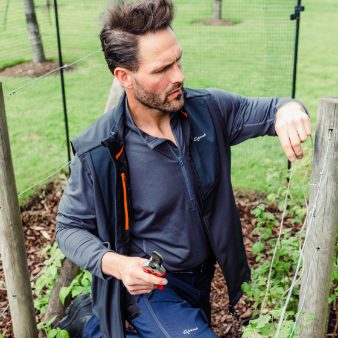April - a month of change

Now we are officially into spring.. with longer brighter mornings.. and the gentle stirring of life in the warming ground.
This is most definitely a month where you can blink, and see something new appearing on a daily basis throughout the garden! It’s always amazes me how fast everything grows in the space of one month.
While writing this blog, I’m trying not to get too distracted by the billowing white blossom of our incredible Prunus ‘Shirotae’ above me! It is by far THE most magnificent of all our trees that we’ve planted here. A close second is the pretty malus ‘Evereste’ which has gorgeous pink buds that open into single white blossom flowers, followed by clusters of dainty crab apples in the autumn.
It’s a real joy to be out in the garden, surrounded by all the joyful elements of spring, with the humming of the bees, and the chirping of the birds… most mornings I wander through the garden to check on the tulips we planted back in January, its so rewarding seeing them popping up throughout some of the garden borders and pots.
It’s an ideal time to start visiting nearby open gardens, and maybe even booking a visit to a big garden event too. This was something I used to do before we started creating our garden here at The Laundry. It gave us many opportunities to meet other gardeners, and understand what plants grow well in our area. It is also a golden opportunity to buy their plants, knowing they should perform well in your own garden. At least a quarter of all plants in our garden have either come from plants we’ve bought in local open garden events, or given to us by fellow gardeners and friends.
On 27th and 28th April, 11am-4pm, we will be opening our garden for the National Garden Scheme, and would love you to join us. Simply head to our website and head to our ‘Events’ page, there’s no need to book, just turn up...there will be plant sales and lots of homemade teas.
As the ground begins to warm up, and many plants begin to emerge, come into bud, leaf and flower.. here are a few jobs we will be getting on with here..
1- Prepare and feed - If you are preparing to plant up a brand-new bed or simply want to give your plants a boost, then now is a great time to get on top of the weeds and boost your plants with a slow release fertiliser like blood, fish and bone or chicken manure pellets. You can also use well rotted manure, which will act as a weed suppressant and help retain some moisture to the roots during the summer months.
2- Now is your last chance to pot up dahlia tubers. Place the tuber into a pot that it will sit snugly into, pop a little peat free compost at the bottom of the pot, place the tuber inside, then gently top it up with more compost to cover it, leaving the tip of last years stump sticking out. Water enough to moisten the compost, leave on a sunny windowsill or greenhouse and don’t water again until you see new shoots appearing in 2-3 weeks time. More on what to do next in next moths blog!
3- Order and plant out gladioli corms, and half hardy annuals. If you haven’t tried growing gladioli or Gladiolus murielae, then let me take this opportunity to highly recommend them as brilliant fillers for your garden they also make great cut flowers. You can plant them between now and May, depending on how late you want them to flower!
4- Prune our goblet trained fig tree, around mid April and again in early to mid summer. This helps to keep it in shape and good health. Make sure to wear gloves as the sap is an irritant! Start from the base, cutting away any frost damaged and crossing branches. If the fig is trained against a wall, treat it much like any other fan trained tree. Growth towards and away from the wall is pruned back to the main structure. Dead wood or frosted tips are removed.
If the fig is in a pot or planted in a restricted space, but free to attain a goblet shape, any unwanted growth can be pruned back to the trunk. If a stub is left, that will sprout fresh growth. Little fruit buds should be visible now from last year, and they will provide this year's figs. Our fig is planted against a south facing wall. It is in the ground, its roots restricted within an old water tank. We half filled this with bricks before planting the fig in a sandy soil mix. It is never fertilised, and has never been watered.
5- Get on top of unwelcome seedlings in pathways. A frequently asked question is how we keep our gravel pathways clear and April is certainly the best time to make a start on keeping any little accidental seedlings at bay. There are two things that work well for us. Firstly, hoeing on a nice dry day when the sun is bright, and secondly, acetic acid (Strong vinegar). Before being attacking the pathway too hastily, always have a closer look at what you’re tackling because sometimes you might actually want to pot up these little treasures and move them to somewhere else in the garden! We also use this method when spring cleaning our front terrace.
Wishing you a wonderful month of gardening!







